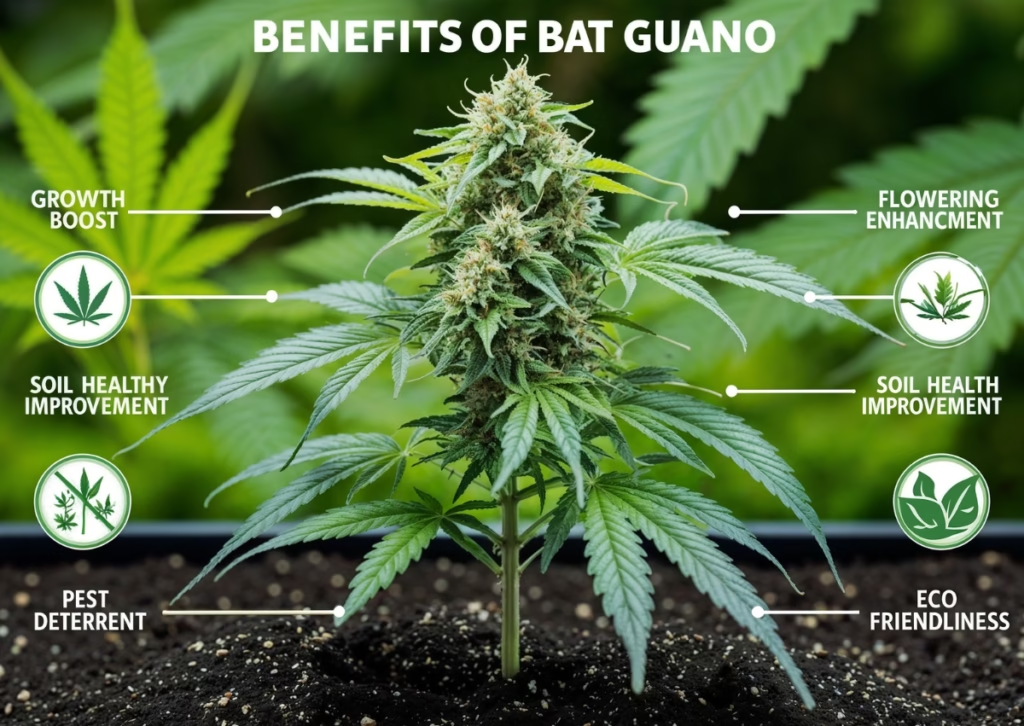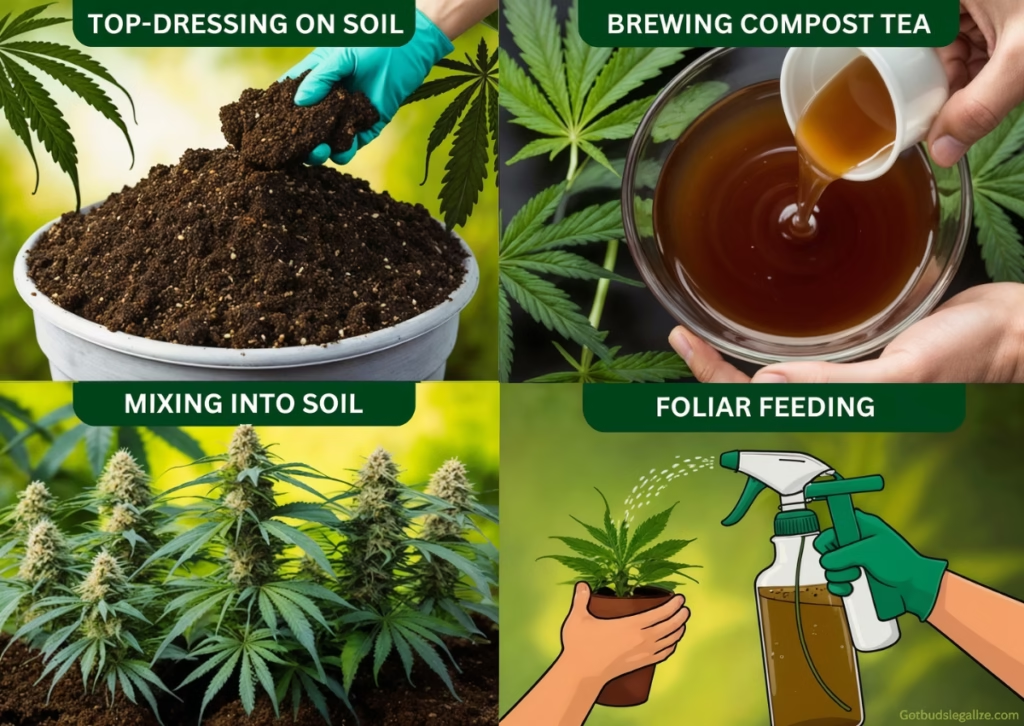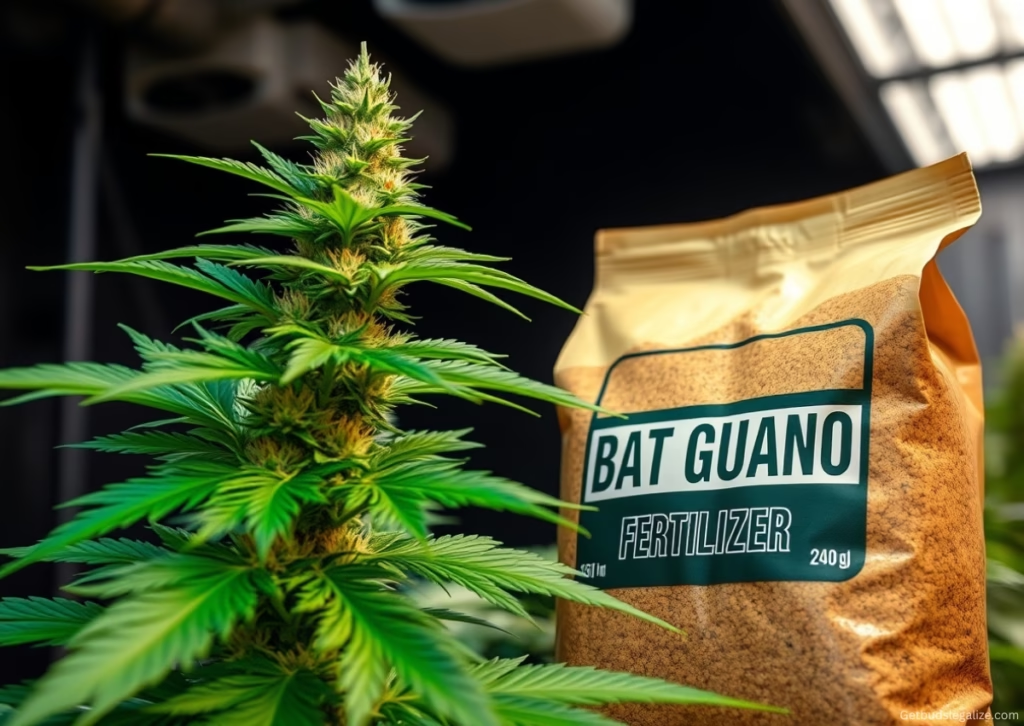How to Use Bat Guano on Weed Plants: A Comprehensive Guide

How to Use Bat Guano on Weed Plants: Boost Growth, Flowering, and Yield Naturally
Bat guano is the secret behind some of the healthiest, most vibrant cannabis plants. Packed with essential nutrients and beneficial microbes, this organic fertilizer has been transforming gardens for centuries. Whether you’re a seasoned grower or just getting started, learn how bat guano can boost your cannabis plants’ growth, enhance flowering, and increase yields.
In this ultimate guide, we'll cover everything you need to know about using bat guano for cannabis—its benefits, how to apply it, and safety tips to keep in mind for successful and healthy cultivation.
What Is Bat Guano and Why Should You Use It for Cannabis?
Bat guano refers to the droppings of bats, which serve as a natural fertilizer. It is rich in essential nutrients and beneficial microbes that help promote plant health.
Bat guano contains three key macronutrients that cannabis plants need to thrive:
- Nitrogen (N): Promotes lush, green foliage and supports strong vegetative growth.- Phosphorus (P): Stimulates root development, flowering, and bud production.
- Potassium (K): Improves overall plant health, boosts disease resistance, and supports optimal growth.
In addition to these vital nutrients, bat guano contains beneficial microorganisms that improve soil structure and enhance nutrient absorption. For cannabis growers, this translates to healthier plants, more robust growth, and larger yields.

Top 5 Benefits of Bat Guano for Your Cannabis Garden
Using bat guano in your cannabis cultivation process offers several advantages:
- Boosts Growth: The high nitrogen content supports vigorous vegetative growth, leading to larger, healthier plants.- Enhances Flowering: With its rich phosphorus content, bat guano promotes healthy, abundant buds during the flowering phase.
- Improves Soil Health: Bat guano enriches the soil with organic matter, improving aeration, water retention, and microbial activity.
- Natural Pest Deterrent: The scent of guano can help deter certain pests, reducing the need for harmful chemicals.
- Eco-Friendly: Bat guano is a sustainable, organic fertilizer that’s safe for the environment and your plants.
- Why use it? The high nitrogen content promotes healthy, leafy growth. It’s perfect for supporting vigorous vegetative development in cannabis plants.
- When to use it? During the vegetative stage when your plants need strong leaf and stem growth.
- Why use it? Rich in phosphorus, this type supports bud development, root growth, and overall plant energy during the flowering stage.
- When to use it? During the flowering stage when your plants need more phosphorus to produce dense, resinous buds.
- Why use it? Contains a balance of nitrogen, phosphorus, and potassium, making it great for overall plant health at any growth stage.
- When to use it? For general use throughout the entire growing cycle.
By selecting the right type of guano for each phase of growth, you’ll maximize your cannabis plants’ potential.

How to Apply Bat Guano: Techniques for Optimal Cannabis Yields
There are several ways to use bat guano as a fertilizer for cannabis plants. Choose the method that best suits your growing setup and plant needs.
1. Top-Dressing With Bat Guano- How to apply: Sprinkle bat guano directly onto the soil around the base of your plants.- When to use: Both the vegetative and flowering stages.
- Dosage: Use approximately 1-2 tablespoons per gallon of soil.
- Tip: Water thoroughly after application to help nutrients seep into the soil.
- Mix Ingredients: In a clean container, add 1-2 tablespoons of bat guano to 1 gallon of non-chlorinated water.
- Add Molasses: Stir in 1 teaspoon of unsulfured molasses to feed beneficial microbes, enhancing their activity.
- Aerate the Mixture: Use an aquarium air pump or aerator to oxygenate the tea. This keeps the mixture aerobic, promoting the growth of beneficial microorganisms. Let it bubble for 24-48 hours.
- Strain the Liquid: Remove solids by straining through a cheesecloth or fine mesh.
- Use Immediately: Apply the nutrient-rich tea directly to the soil or as a foliar spray.
- How to apply: Mix bat guano into your potting soil before planting.
- Dosage: Add 1-2 cups per cubic foot of soil.
- When to use: During the preparation of your grow medium.
- How to apply: Dilute bat guano tea further (1 tablespoon per gallon of water) and spray it directly onto leaves.
- Benefits: Delivers nutrients quickly through leaf absorption.
- When to use: During the vegetative stage for a nitrogen boost.
- Troubleshooting Tip: If you notice yellowing leaves, reduce the dosage to prevent nutrient burn.

Calculating the Right Amount of Bat Guano for Your Grow Area
It’s important to calculate the right amount of bat guano to avoid over-fertilizing. Here's how to determine the right dosage based on your grow area:
For Small Pots (Up to 5 Gallons)- Use 1-2 tablespoons of bat guano per gallon of soil.- Apply as a top dressing or mix it into the soil.
- Use 2-4 tablespoons of bat guano per gallon of soil.
- Thoroughly mix it into the soil or apply it as a top dressing.
- For small plots (around 4x4 feet), apply 2-3 cups of bat guano evenly throughout the soil.
- For larger grow spaces, use 1-2 cups per 10 square feet.
- Wear protective gear: Use gloves, masks, and goggles when handling bat guano.
- Work in a ventilated area: Avoid inhaling dust or spores.
- Source reputable products: Purchase bat guano from trusted suppliers to minimize contamination risks.
- Store properly: Keep bat guano in a sealed container away from living spaces.
- Wash hands thoroughly: Clean up immediately after handling.
What to watch for: Symptoms of histoplasmosis (a respiratory illness from fungal spores) include persistent cough, shortness of breath, and fever. Seek medical attention if you suspect exposure.

When Should You Avoid Using Bat Guano?
Bat guano may not be suitable in the following cases:
- If you have respiratory issues or allergies, the dust can irritate your lungs.- In hydroponic systems, bat guano can clog water lines and filters.
- If your plants are already nutrient-burned, guano can exacerbate the issue.
Alternatives: Consider worm castings or fish emulsion for similar organic benefits without the risk of airborne spores.
Conclusion: Boost Cannabis Yields Naturally With Bat Guano
Bat guano is more than just a fertilizer; it’s an all-natural, powerful solution for enhancing your cannabis garden’s health and maximizing yields. By selecting the right type of bat guano and applying it correctly, you can unlock its full potential for cultivating stronger, more vibrant plants.
Get ready to grow bigger, healthier, and more abundant cannabis with this time-tested, organic resource.
Have you used bat guano in your cannabis garden? We’d love to hear your results and tips—join the conversation on our Facebook page!
For expert cannabis growing tips, subscribe to our newsletter and stay in the know about the latest trends in organic fertilizers.
Frequently Asked Questions (FAQs) about How to Use Bat Guano on Plants
What is bat guano, and why is it good for cannabis plants?
Bat guano is an organic fertilizer made from bat poop, rich in essential nutrients like nitrogen, phosphorus, and potassium. It enhances cannabis growth by promoting robust foliage, improving root development, and encouraging healthy bud formation.
Bat guano also boosts soil health and provides natural pest-deterrent properties, making it an ideal choice for cannabis cultivation.
Which type of bat guano is best for cannabis plants?
There are three main types of bat guano, each suited for specific stages of cannabis growth:
- High Nitrogen Guano: Ideal for the vegetative stage, promoting strong leafy growth.- High Phosphorus Guano: Best used during the flowering stage to enhance bud production and root development.
- Balanced Guano: A versatile option for general use throughout the growth cycle.
How do I apply bat guano to cannabis plants?
You can apply bat guano in several ways:
- Top-Dressing: Sprinkle bat guano directly onto the soil surface and water well.- Compost Tea: Brew bat guano with water and apply as a liquid fertilizer.
- Soil Amendment: Mix bat guano directly into the soil before planting.
- Foliar Spray: Dilute bat guano tea and mist onto leaves, especially during the vegetative stage for a nutrient boost.
How much bat guano should I use?
The amount of bat guano varies depending on the size of your pots and growing area:
- Small Pots (Up to 5 Gallons): 1-2 tablespoons per gallon of soil.- Larger Pots (5-10 Gallons): 2-4 tablespoons per gallon of soil.
- Outdoor Grow Areas: 1-2 cups per 10 square feet of soil.
- Compost Tea: 1-2 tablespoons per gallon of water every 2-3 weeks.
Can bat guano be used in hydroponic systems?
No, bat guano is not recommended for hydroponic systems. It can clog water lines and filters, making it unsuitable for this type of cultivation.
Are there safety precautions when using bat guano?
Yes, bat guano can contain fungal spores, such as those causing histoplasmosis. To stay safe:
- Wear gloves, masks, and goggles.- Handle bat guano in a well-ventilated area.
- Purchase from reputable suppliers to reduce contamination risks.
- Store bat guano in sealed containers and wash your hands thoroughly after handling.
What are the signs of over-fertilization with bat guano?
Overuse of bat guano may lead to nutrient burn. Symptoms include yellowing or browning of leaf tips. If this occurs, reduce the dosage and adjust application rates to avoid further damage.
Can I use bat guano with other fertilizers?
Yes, bat guano works well with other organic fertilizers, such as worm castings or fish emulsions. However, be cautious not to over-fertilize, and always monitor your plants for signs of nutrient excess.
Is bat guano eco-friendly?
Yes, bat guano is a sustainable and organic fertilizer. When sourced responsibly, it supports eco-friendly cultivation practices and reduces reliance on synthetic fertilizers.
Are there alternatives to bat guano?
If bat guano isn’t suitable for your grow setup, consider these alternatives:
- Worm Castings: A nutrient-rich alternative that enhances soil structure and provides essential minerals for healthy plant growth.- Fish Emulsion: High in nitrogen, this liquid fertilizer promotes strong vegetative growth and overall plant health.
- Seaweed or Kelp Fertilizers: Rich in trace minerals and beneficial plant hormones, these are great for boosting plant resilience and growth.
- Bone Meal: High in phosphorus, bone meal supports strong root development and flowering, making it a good choice during the blooming phase.
These options can provide similar organic benefits while offering flexibility based on your specific growing needs.
What should I do if I suspect histoplasmosis exposure?
If you experience symptoms such as a persistent cough, shortness of breath, or fever after handling bat guano, seek medical attention immediately.
When should I avoid using bat guano?
It’s best to avoid using bat guano in the following situations:
- Respiratory issues or allergies: The dust and spores in bat guano can irritate the lungs and worsen respiratory conditions.- Nutrient burn: If your plants are already showing signs of nutrient burn, bat guano may exacerbate the problem.
- Hydroponic systems: Bat guano can clog water lines and filters, making it unsuitable for hydroponic setups.
In these cases, consider alternative fertilizers or adjust your nutrient application methods.
Can I use bat guano for both indoor and outdoor cannabis plants?
Yes, bat guano can be used for both indoor and outdoor cannabis cultivation. However, ensure proper ventilation indoors to avoid inhaling spores.
Is bat guano safe for seedlings?
Use bat guano sparingly with seedlings, especially in tea form. Diluting compost tea provides a gentle nutrient boost without overwhelming young plants.
How often should I apply bat guano?
Apply bat guano every 2-3 weeks, depending on your cannabis plants’ growth stage and nutrient needs. Adjust application frequency based on plant response.
Can I combine bat guano with other fertilizers?
Yes, bat guano can be combined with other organic fertilizers. However, be mindful of nutrient levels to avoid over-fertilizing and monitor your plants’ health regularly.
Is bat guano sustainable, and how does harvesting affect bat populations?
Ethical sourcing is key to ensuring that bat populations are not harmed during guano collection. Always choose suppliers who follow sustainable harvesting practices to minimize environmental impact.
What is a good bat guano tea recipe?
Here’s a simple and effective bat guano tea recipe to boost your plants’ health:
Ingredients:
- 1-2 tablespoons of bat guano (choose nitrogen-rich guano for leafy plants or phosphorus-rich guano for flowering and fruiting plants).- 1 gallon of non-chlorinated water (let tap water sit for 24 hours to remove chlorine).
- 1 teaspoon unsulfured molasses (for microbial growth).
- Cheesecloth or mesh bag (optional, to hold the guano).
- Aquarium air pump or aerator (optional, for optimal microbial activity).
- Mix the Guano: Place the bat guano in a cheesecloth or mesh bag for easy removal, or mix it directly into the water.
- Add Molasses: Stir in 1 teaspoon of unsulfured molasses to feed beneficial microbes.
- Aerate the Mixture (Highly Recommended): Use an aquarium air pump to oxygenate the tea for 24-48 hours. This boosts microbial activity and prevents harmful anaerobic conditions.
- Steep Without Aeration (If You Don’t Have a Pump): Let the mixture sit for 24-48 hours, stirring occasionally to keep it well-distributed.
- Strain the Tea: If you didn’t use a bag for the guano, strain the liquid through a cheesecloth to remove solid particles.
- Apply Immediately: Use the tea within 24 hours for maximum freshness and effectiveness.
Can I store bat guano tea?
It’s best to use bat guano tea immediately after brewing for maximum effectiveness. Storing it for extended periods can reduce its potency.
How often should I apply bat guano tea?
Apply bat guano tea every 2-3 weeks during both the vegetative and flowering stages for optimal plant growth.
Can I use bat guano tea for foliar feeding?
Yes, bat guano tea can be used for foliar feeding.
https://getbudslegalize.com/how-to-use-bat-guano-on-weed-plants-guide/
Commenti
Posta un commento